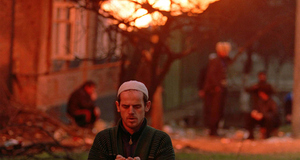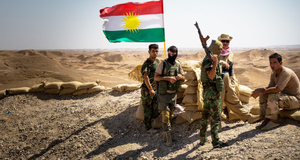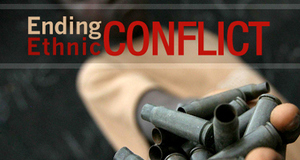The Turkish-Kurdish Conflict in Theory and Practice"Identity" and "Reality Perception" in the Context of Ethnic ConflictA three pronged model for understanding “ethnicity” In order to have a “full understanding of the broader nature of the phenomenon of ethnicity,” Wsevolod Isajiw claims that we must study ethnic identity outside of the paradigms that limit our objective viewpoint. Such paradigms include the idea that ethnic conflict is a “pre-modern” notion and that the majority group affiliated is “non-ethnic” (2000, pg. 105). Scholars Marsella and Yegen claim, though, that in order to fully conceptualize “ethnicity” properly, we must look at the cultural context and historical period respectively, both of which are constructions that define, not paradigms that restrict understanding. Before we can study the phenomenon, Anthony Marsella of the University of Hawaii contends that we must fully understand the terms we are studying. He says that “culture is shared learning behavior and meanings…for purposes of individual and collective adjustment and adaption” (Marsella, 2005, pg. 657). From this article, culture is defined as a broad spectrum and inescapable context from which to live and learn. Although not entirely static, “culture” is, in my own understanding, a noun. From this term we can begin to define ethnicity. Isajiw describes ethnicity as a fluid and ever-changing “social phenomenon” (2000, pg. 106). In other words, ethnicity is determined by racial roots and is an adjective. Both Isajiw and Yegen then consider nationalism as part of this identity model. Yegen articulates nationalism as being a devotion to one’s national culture and the desire for autonomy (2006, pg. 121). Isajiw writes of nationalism as a criterion for understanding ethnic identity (2000, pg. 106). In both articles, the scholars agree that nationalism is always changing and, as I see it, claim that it is neither a noun nor adjective, but is a choice.Identity theories and criticisms Academics and social scientists present many different versions of identity analysis and, more currently, criticisms that these theories are inapplicable to resolving conflict. The Social Identity Theory (SIT) is one of the foremost theories applied to group, and more specifically, ethnic conflicts. SIT assumes that all humans desire a favorable social identity and form this identity based on in-group or out-group membership (Brown, 2000, pg. 747). Stereotyping and categorization is fundamental to SIT as they maintain group and self-esteem (Cuhadar and Dayton, 2000, pg. 274) and directly related to these is prejudice, “an antipathy based upon a faulty and inflexible generalization” (2000, pg. 277). Social Identity Theory, thus, explains that intergroup conflict is a result of intragroup constructed discrimination (Isajiw, 2000, pg. 110); however, Isajiw proceeds to argue that SIT does not account for broader factors outside of the in/out-groups (2000, pg. 110). For example, Yegen explains that discrimination towards the Kurds by the Turks was not a result of mere group differences but was an active movement by the Turks to exclude and change the Kurds to conform to the standards of their in-group (Yegen, 2006, pg. 122). According to Brown, SIT has made only four significant contributions to the understanding of ethnic conflict, one of which – understanding stereotyping and prejudice - was mentioned above. Applicable to the Kurdish question is what he identifies as the SIT’s link between identity and discontent (Brown, 2000, pg. 749). A sub-theory of SIT composed by Gurr, Relative Deprivation Theory (RDT) proposes that when a group does not receive what it believes it deserves, the group becomes dissatisfied. Collective action follows (Brown, 2000, pg. 749). Yegen, while outlining the effects of Turkish nationalism on Kurds, brings to light several examples of RDT. For example, the 1924 Constitution for the Republic stated that Turkey is “not a multi-national state. The state does not recognize any nation other than the Turks” (Yegen, 2006, pg. 126). The Kurds were stripped of any legal or cultural rights and their language was forbidden. Yegen notes that collective action in the form of revolts soon followed this deprivation of, what the Kurds believed to be, their inherent rights (2006, pg. 127). Brown describes several problems with SIT, one of which he calls “the effects of intergroup similarity.” Social Identity Theory asserts that similar groups should be logically inclined to emphasize intergroup differences, yet studies show that some groups show more interaction (Brown, 2000, pg. 757). If the theory held true, the Kurds and the Syrians, both of whom desire some sort of autonomy or control from Turkey would accentuate differences between their groups, yet they have united against Turkey. SIT, in this case, does not explain out-groups uniting against an in-group. Another problem with SIT, according to Brown, is the inability for theorists to make any sort of prediction concerning the actions of the low-status group because the theory is too one-dimensional (2000, pg. 758). Other theories that group conflict scholars have used are the Basic Human Needs theory and Psychodynamic Theory. The Basic Human Needs theory emphasizes identity and security as two of the most important needs, along with belongingness, and Ozcelik theorizes that the oppression of the Kurdish language and culture, as stated before, is “the main reason for conflict in Turkey;” however, universalizing human needs between various groups is virtually impossible (2006, pg. 4). BHN theory also does not provide any form of solution to conflict. The Psychodynamic Theory emphasizes, of course, the cognitive functions of the human brain, focusing more on individual (within a group) conflict dynamics rather than the group as a functioning whole. According to Linda Smircich’s psychodynamics, culture is a “manifestation… of the mind’s unconscious operation,” (1983, pg. 11) and she claims that, in order to understand interpersonal dynamics, we must analyze social underpinnings in a much deeper and objective sense (1983, pg. 15). James Krantz, a leading scholar on “organizational change,” brings to light what I believe to be very relevant insight on the psychodynamics of change, a phenomenon that most, if not all, ethnic groups experience. He says that “periods of change in organizations put great strain on the ability of their members to contain their anxieties” (Krantz, 2001, pg. 1). He emphasizes that substantial change and loss of the familiar leads to the “paranoid-schizoid mode.” This mode is notable for its members’ reversion to “primitive defenses,” such as denial, violence and projective identification, all caused by the undeniable anxiety of identity confusion (2001, pg. 4) Ozcelik reinforces this idea, asserting that when groups’ psychological borders (which protect ethnic uniqueness and autonomy) are threatened, they will resort to violence rather than live in anxiety (2006, pg. 7). For example, the Kurds, though never fully assimilated into the Ottoman Empire, were integrated into society and allowed to retain their cultural identity; however, from the time of Ottoman downfall to present day, their cultural autonomy has been threatened by the Turks’ political reform/centralization programs. These nationalist reforms stimulated and disseminated Kurdish anxiety (Yegen, 2006, pg. 127). Though this theory provides great insight to the unconscious actions of individuals and groups within conflict, it is not beneficial in explaining motives and it does not provide a solution for post-change conflict. Perception theories and criticisms Many scholars believe that group perception of reality is greatly dependent on identity. Krantz claims that destructive and rapid change for a group results in a confused identity for the minority while the majority retains a static identity. This, he says, results in the changing group’s “primitive” reality perception, characterized by fantasies of omnipotent control and paranoid blaming. Yegen speaking more specifically, states that Turkish nationalist identity, as defined earlier, has shaped how the Turks have perceived the Kurdish question over the years, virtually disabling them from understanding the conflict as an ethnic question (Yegen, 2006, pg. 119). In a broader sense, I believe that Yegen is claiming that ethnic conflicts are usually perceived in the context of the historical paradigm in which the in-group or outsiders are restricted. Perception theories included here are the Realistic Group Conflict Theory and Psychocultural Theory. Realistic Group Conflict theory emphasizes competition over material resources as being the primary origin of group conflict (Cuhadar and Dayton, 2011, pg. 280). Isajiw cites the work of M. Sherif who made many contributions to this theory. Sherif claimed that “it is the objective fact of this type of competition that creates hostile perceptions and biases of one group against another” (Isajiw, 2000, pg. 110). For instance, competition for control of the Euphrates River has led to Syrian support of the terrorist PKK organization. This, in turn, created a very distrustful perception of Syria and, of course, expanded the Kurdish dilemma from a domestic problem to an international one (Ozcelik, 2000, pg. 6). When applied to the Turkish-Kurdish conflict, however, Realistic Group Conflict theory does not fit. Critics of the Realistic Group Conflict theory claim that it does not explain why inter-group conflict occurs when there is not material competition (Cuhadar and Dayton, 2011, pg. 280). According to James and Ozdamar, the Kurds desire autonomy, rights, and a unified identity - all of which are non-material objectives. Isajiw also notes that this theory does not account for intergroup perceptions which were formed before group competition or before intergroup bias (2000, pg. 110). Counter to Realistic Group Conflict theory, Psychocultural Theory asserts that motive develops after change of perception. This relatively new theory, born out of Psychodynamic theory, “gives a central role to culturally rooted social and psychological processes which produce dispositions-shared images, perceptions of the external world, and motives for individual and group behavior” (Ross, 1995, pg. 525). As mentioned before in the three-pronged model for understanding identity, culture is of utmost importance. Ross claims that people of the same culture give the same meaning to certain experiences or objects. “Because identity is a function of one's relations with others, a change in relationships is a source of intense threat and anxiety,” he says (Ross, 1995, pg. 529). He goes on to explain that, when forced to change in a fundamental way, the aforementioned perceptions develop into new interpretations of the world due to anxiety (Ross, 1995, pg. 525). The new interpretations take on extreme social and political connotations and now act as a motive guides (Ross, 1995, pg. 529).Continued on Next Page » Suggested Reading from Inquiries Journal
Inquiries Journal provides undergraduate and graduate students around the world a platform for the wide dissemination of academic work over a range of core disciplines. Representing the work of students from hundreds of institutions around the globe, Inquiries Journal's large database of academic articles is completely free. Learn more | Blog | Submit Latest in International Affairs |


















